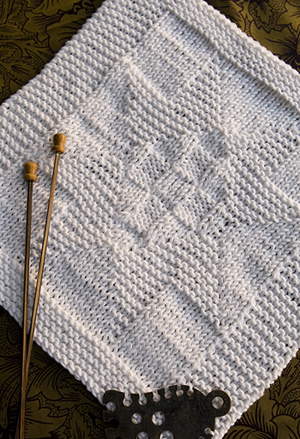

|
|
|
|
A character like Rachel Lynde is a rara avis in modern fiction: a serious knitter who is also an stone-cold pain in the ass. She’s the hustle behind four of the town’s charitable organizations, but there’s nothing saintly or nurturing in her personality. She does not sport more halo than a skein of angora. She would not bring homemade cupcakes to The Friday Night Knitting Club. She would be summarily ejected from The Shop on Blossom Street for telling the ladies there’s nothing wrong with their lives that couldn’t be cured by proper corsets and castor oil. I just love her. I love her so much that I did a little dance (Mrs. Lynde would not approve) after turning up a A Knitting-Book of Counterpanes: Toilet-Covers, Pincushions, and Other Articles of Fancy Work, put forth in 1871 by Mrs. George Cupples.* Mrs. Cupples’ counterpane, you see, is a sibling of Mrs. Lynde’s quilt. Both were products of the 19th and early 20th century passion for “white work”–ornate knitting and crochet made with fine cotton. Here, at last, was a small but tantalizing collection of patterns for knitting my very own quilt, the better to emulate my fictional heroine. Of course, a knitted quilt is not, strictly speaking, a “quilt.” It is not an article of bedding formed of multiple layers penetrated and united by patterned stitching. Any quilter will tell you this, even if you don’t ask. But Victorian needlework publishers–and presumably, their readers–do not appear unanimously to have observed this distinction. They used “quilt” interchangeably with blanket and counterpane. It was big. It was squarish. It was warm. You put it on the bed. Therefore, it was a quilt.
Hundreds of sewn quilt blocks were invented during the peak of patchwork’s popularity in the nineteenth century. Probably the most common motif is the star; its variations alone could–and in fact do–fill several weighty volumes. Mrs. Cupples opens her book with eight counterpane blocks, one of which bears a strong family resemblance to a famous and beloved point of light from the quilt galaxy, the Ohio Star [shown at right].**  And don’t sweat it if you think the star looks like fun but aren’t inclined to commit to a whole quilt. Mrs. Cupples herself wholeheartedly encourages you to Do Your Own Thing, noting that, “the intelligent worker will not fail to perceive that the patterns are suitable for other descriptions of ornamental knitting, such as Tidies, Toilet Covers, Pincushions, Mats, etc.” True dat. Me, I knit the test block in cotton [shown at left] and then turned queasy at the thought of repeating it 49 times. So I swapped for wool on the second go, and made a pincushion. Mrs. Lynde would probably call me a slacker. But Mrs. Cupples has my back. * She also, according to the title page, wrote The Stocking-Knitter’s Manual. I’d like to see that. ** Really, it looks like an Ohio Star with a small nine-patch caught in its throat. I have been digging around in lists of star blocks, but haven’t found a closer match yet. Anybody know of one? |
|
 |
translated by Franklin Habit from A
Knitting-Book of Counterpanes: Toilet-Covers,
Pincushions, and Other Articles of Fancy
Work (1871) by
Mrs. George Cupples.
|
|
FINISHED MEASUREMENTS |
Will vary according to choice of yarn and
needles. |
|
MATERIALS Notions |
| GAUGE |
32 sts/48 rows = 4 inches in stockinette stitch |
|
PATTERN NOTES |
The star pattern, worked on the center 34 stitches of the block, is surrounded by a border of garter stitch. Mrs. Cupples calls for 8 stitches in the right and left borders; but if you plan to assemble multiple blocks for a blanket, consider reducing them to 4 stitches each (a total of 42 sts to CO). This will give you vertical and horizontal borders of similar widths after sewing. Star Pattern Row 1 [WS]: P9, k1, p14, k1, p9.
|
|
DIRECTIONS |
 Lower Border Body Upper Border BO.
FINISHING
|
|
|
| ABOUT THE DESIGNER |
 He doesn't loll about living history museums all day, since men in living history museums don't get to knit. |
| Pattern & images © 2011. Franklin Habit. |